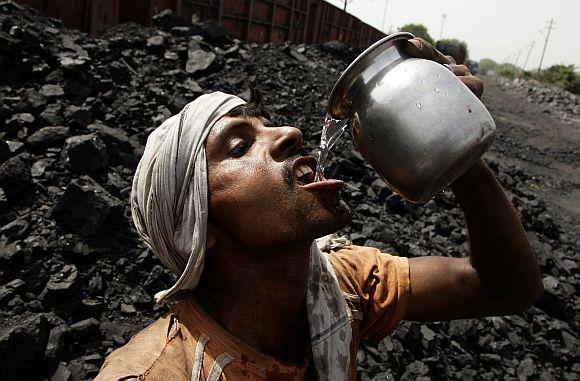
The battles of yesterday were fought over land. Those of today are over energy. But the battles of tomorrow may be over water. Along with population growth and increasing per capita water consumption, massive pollution of the world's surface water systems has placed a great strain on remaining supplies of clean fresh water. Global deforestation, destruction of wetlands, dumping of pesticides and fertilizer into waterways, and global warming are all taking a terrible toll on the Earth's fragile water system, writes Dr Nitish Priyadarshi.
The combination of increasing demand and shrinking supply has attracted the interest of global corporations who want to sell water for a profit. The water industry is touted by the World Bank as a potential trillion-dollar industry. Water has become the "blue gold" of the 21st century.
In any part of the world, one major river supplies water to multiple countries. Climate change, pollution and population growth are putting a significant strain on supplies. In some areas renewable water reserves are in danger of dropping below the 500 cubic meters per person per year -- considered minimum for a functioning society.
In recent times, several studies around the globe show that climatic change is likely to impact significantly upon availability of freshwater resources. In India, demand for water has already increased manifold over the years due to urbanisation, agriculture expansion, increasing population, rapid industrialisation and economic development.
At present, changes in cropping and land-use patterns, over-exploitation of water storage and changes in irrigation and drainage are modifying the hydrological cycle in many climate regions and river basins of India.
Geologist Dr Nitish Priyadarshi is presently associated with environmental management and planning, Department of Geology, Ranchi University.
Please click NEXT to read futrher...
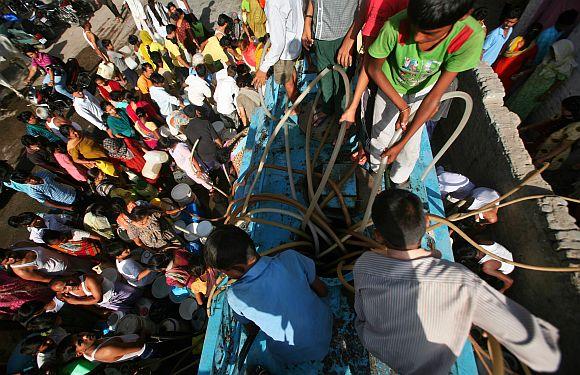
Major cities worldwide may face a water shortage crisis by 2050 if relevant governments don't react quickly. The water shortage will mostly affect basic daily needs such as drinking, cooking, bathing and washing clothes, and the poor residents of the world's major cities in developing countries are the ones who will suffer most.
By 2050, big cities that will not have enough water available nearby include Beijing, New Delhi, Mexico City, Lagos and Tehran. China and India will be particularly hard hit unless significant new efforts are taken by their cities.
There are the several principal manifestations of the water crisis:
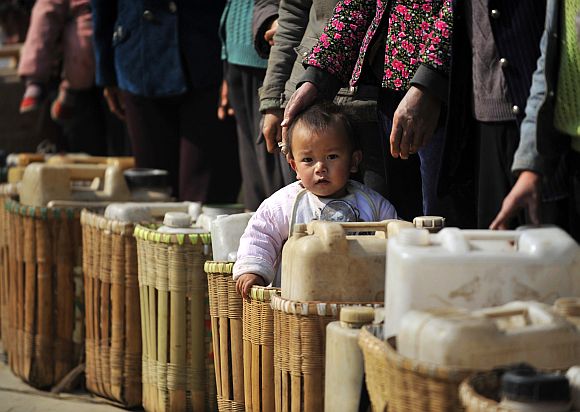
Here are the potential hot spots:
Egypt: A coalition led by Ethiopia is challenging old agreements that allow Egypt to use more than 50 percent of the Nile's flow. Without the river, all of Egypt would be desert.
Eastern Europe: Decades of pollution have fouled the Danube, leaving down-stream countries, such as Hungary and the Republic of Moldova, scrambling to find new sources of water.
Middle East: The Jordan River, racked by drought and diverted by Israeli, Syrian and the Jordanian dams, has lost 95 percent of its former flow.
Former Soviet Union: The Aral sea, at one time the world's fourth largest inland sea, has lost 75 percent of its water because of diversion programs begun in the 1960s.
There are many other countries of the world that are severely impacted with regard to human health and inadequate drinking water.
Water stress is set to become Asia's defining crisis of the twenty-first century, creating obstacles to economic growth, stoking interstate tensions over shared resources, exacerbating long time territorial disputes, and imposing further hardships on the poor.
Asia is home to many of the world's great rivers and lakes, but its huge population, pollution and exploding economic and agricultural demand for water make it the most water-scare continent on a per capita basis. Many of Asia's water sources cross national boundaries, and as less and less water is available, international tensions will rise.
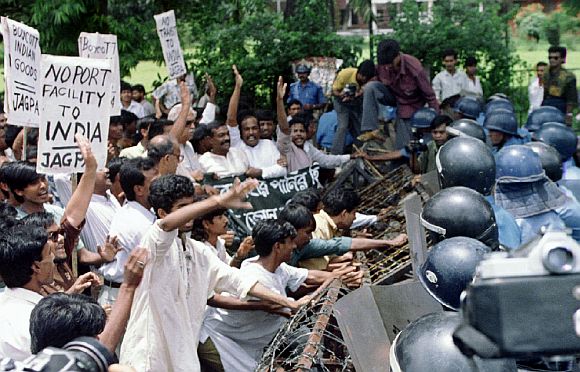
The poor management of river basins, environmentally unsustainable irrigation practices, an overuse of groundwater, and the contamination of water sources have all helped aggravate Asian water woes.
The over exploitation of subterranean water in the large parts of the Asia has resulted in a rapidly falling groundwater saturation level, known as the water table.
In the Gangetic delta, wells have tapped into naturally occurring arsenic deposits, causing millions of people in Bangladesh, and Eastern India, including Jharkhand and Bihar, to be exposed to high levels of poisonous arsenic in drinking water and staple agricultural products like rice.
Asia will continue to have the world's largest number of people without basic or adequate access to water. The Asian water sector is plagued by serious problems, including inadequate infrastructure and poor system maintenance, financially strapped utilities, low-cost recovery, growing pollution, watershed degradation, and unsustainable groundwater extraction.
Owing to leaks and system inefficiencies, a sizable portion of the water supply is lost before reaching the consumer.
As water distress intensifies and global warming accelerates, local, national, and interstate disputes over water are likely to become endemic in Asia.
Water, for its part, could trigger increased conflicts within and between states, and open new political disputes in Asia. Water shortages, likely to be aggravated by fast-rising use and climate change, pose a potential threat to political stability, economic modernisation, public health, food security, and internal cohesion in a number of Asian states.
The sharing of waters of the river Kaveri had been the bone of contention of a serious conflict between the states of Karnataka and Tamil Nadu. Parched throats in Rajasthan are crying hoarse over Gujarat allegedly stealing its share of the Mahi river waters by constructing the Sujalam Sufalam irrigation canal.
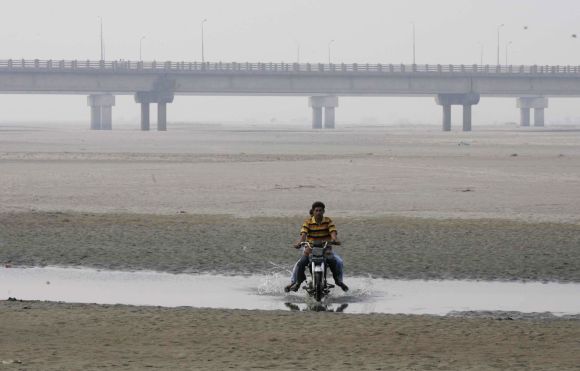
The declining snow cover and receding glaciers in the Himalayan state of Jammu and Kashmir could trigger renewed hostilities between India and Pakistan, neighbouring states in the South Asian region that are at odds on a host of issues.
The two countries share the Indus River, one of the longest rivers in the world. Pakistan and India have long been embroiled in a territorial dispute over Kashmir, but have so far managed to uphold a World Bank-mediated Indus Water Treaty that provides mechanisms for resolving disputes over water sharing. Any drastic reduction in the availability of water in the region has the potential of causing a war between the hostile south Asian neighbours.
Transboundary water sharing between India and Pakistan will become an extremely difficult proposition as surface water would become a scarce commodity with the depletion of water reserves up in the mountains.
The sharing of the Ganga waters is a long-standing issue between India and Bangladesh over the appropriate allocation and development of the water resources of the Ganga that flows from northern India into Bangladesh. The issue has remained a subject of conflict for almost 35 years, with several bilateral agreements and rounds of talks failing to produce results.
The Farakka Barrage is a dam on the Bhagirathi river located in West Bengal, roughly 10 km (6.2 mi) from the border with Bangladesh. India uses it to control the flow of the Ganga. The dam was built to divert the Ganga water into the Hooghly river during the dry season, from January to June, in order to flush out the accumulating silt which in the 1950s and 1960s was a problem at the Kolkata port on the Hooghly river.
Bangladesh claims that its rivers were drying up because of excess drawing of water by India. In May 1974 a joint declaration was issued to resolve the water-sharing issue before the Farakka Barrage was put into operation. This was followed by an interim agreement in 1975 to allow India to operate feeder canals of the barrage for short periods.
However, India withdrew from the process of negotiations by September 1976 as both nations grew apart after the killing of Sheikh Mujib and establishment of military rule. Bangladesh protested India's unilateral action at a summit of the Non-Aligned Movement and at the 31st session of the United Nations General Assembly. At the urging of other nations and the UN, both India and Bangladesh agreed to resume dialogue, but with no results.
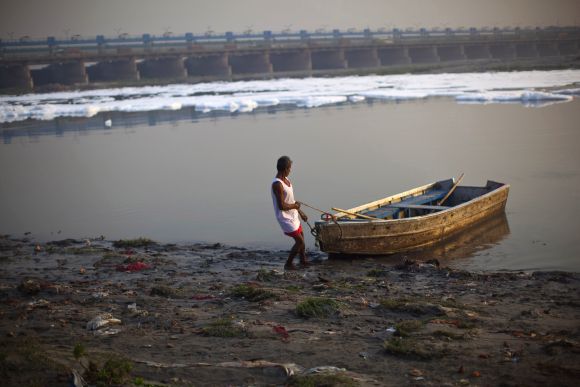
In China, at present, the government estimates that 30 million people are already being displaced by climate change. Some authorities set the figure higher, at up to 72 million. A one-meter rise of sea level would flood of all of Shanghai, plus 96 percent of the province around it.
Egypt will loose 12-15 percent of its arable land, creating 14 million refugees. As the sea encroached, salt water would move into the foreshortened Nile, threatening the irrigated lands that produce almost all of Egypt's food.
In some areas, more destructive river flooding is also predicted, for instance through a heavier than usual monsoon.
In Bangladesh, melting glaciers in the Himalayas would add to such floods.
Rising sea levels also threaten delta areas-such as the Mekong in the Vietnam, the Yangtze in China, the Irrawaddy in Myanmar, the Tigris- Euphrates in Iraq, the Indus in Pakistan, the Orinoco in Venezuela and the Amazon in Brazil -- that hold more than one billion people (two billion by 2050).
Vietnam has engaged in several dam construction projects without consulting with Cambodia, as has Laos.
There is a famous Chinese proverb that warns "not only can water float a boat, it can sink it also." And with global water shortages on the horizon, climate change supporters say an extreme response will be needed from international governments to stem the potential for conflict it will create around the world.
...